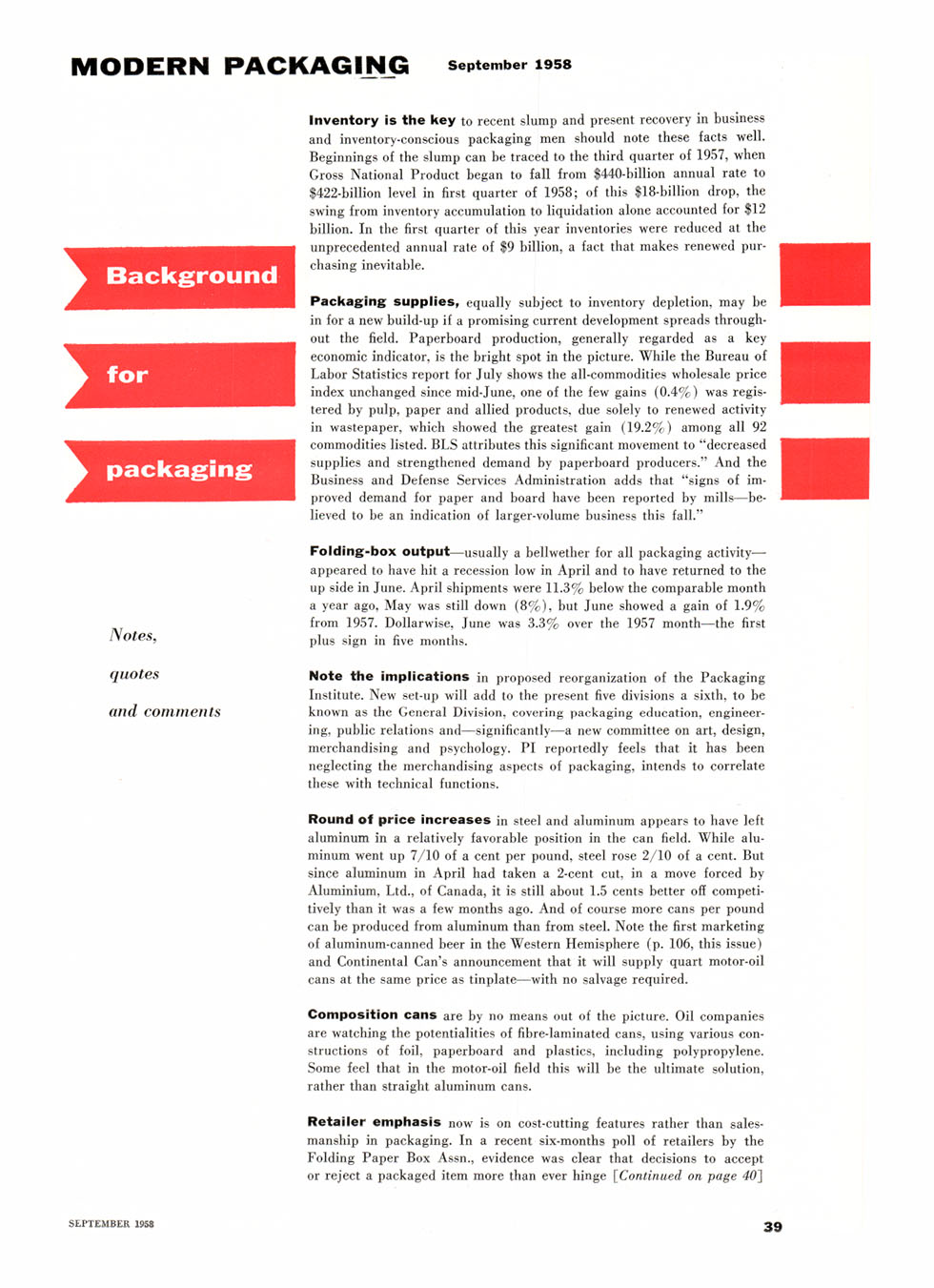


MODERN PACKAGING September 1958
Inventory Is the key to recent slump and present recovery in business and inventory-conscious packaging men should note these facts well. Beginnings of the slump can be traced to the third quarter of 1957, when Gross National Product began to fall from $440-billion annual rate to $422-billion level in first quarter of 1958; of this $18-billion drop, the swing from inventory accumulation to liquidation alone accounted for $12 billion. In the first quarter of this year inventories were reduced at the unprecedented annual rate of $9 billion, a fact that makes renewed purchasing inevitable.
Packaging: supplies, equally subject to inventory depletion, may be in for a new build-up if a promising current development spreads throughout the field. Paperboard production, generally regarded as a key economic indicator, is the bright spot in the picture. While the Bureau of Labor Statistics report for July shows the all-commodities wholesale price index unchanged since mid-June, one of the few gains (0.4%) was registered by pulp, paper and allied products, due solely to renewed activity in wastepaper, which showed the greatest gain (19.2%) among all 92 commodities listed, BLS attributes this significant movement to "decreased supplies and strengthened demand by paperboard producers."¯ And the Business and Defense Services Administration adds that "signs of improved demand for paper and board have been reported by mills- believed to be an indication of larger-volume business this fall."¯
Notes,
Folding-box output usually a bellwether for all packaging activity- appeared to have hit a recession low in April and to have returned to the up side in June. April shipments were 11.3% below the comparable month a year ago, May was still down (8%), but June showed a gain of 1.9% from 1957. Dollarwise, June was 3.3% over the 1957 month the first plus sign in five months.
quotes Note the implications in proposed reorganization of the Packaging
Institute. New set-up will add to the present five divisions a sixth, to be and comments known as the General Division, covering packaging education, engineer
ing, public relations and significantly a new committee on art, design, merchandising and psychology. PI reportedly feels that it has been neglecting the merchandising aspects of packaging, intends to correlate these with technical functions.
Round of price increases in steel and aluminum appears to have left aluminum in a relatively favorable position in the can field. While aluminum went up 7/10 of a cent per pound, steel rose 2/10 of a cent. But since aluminum in April had taken a 2-cent cut, in a move forced by Aluminium, Ltd., of Canada, it is still about 1.5 cents better off competitively than it was a few months ago. And of course more cans per pound can be produced from aluminum than from steel. Note the first marketing of aluminum-canned beer in the Western Hemisphere (p, 106, this issue) and Continental Can's announcement that it will supply quart motor-oil cans at the same price as tinplate - with no salvage required.
Composiā…˛ioti cans are by no means out of the picture. Oil companies are watching the potentialities of fibre-laminated cans, using various constructions of foil, paperboard and plastics, including polypropylene. Some feel that in the motor-oil field this will be the ultimate solution, rather than straight aluminum cans.
Retailer emphasis now is on cost-cutting features rather than salesmanship in packaging. In a recent six-months poll of retailers by the Folding Paper Box Assn., evidence was clear that decisions to accept or reject a packaged item more than ever hinge [Continued on page 40}